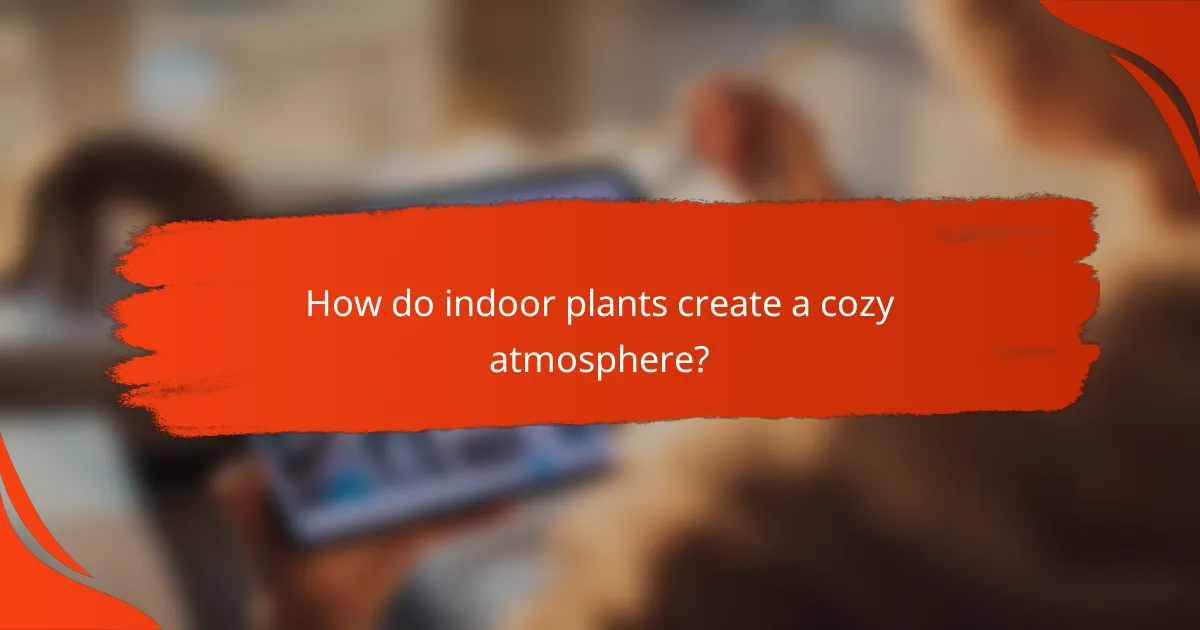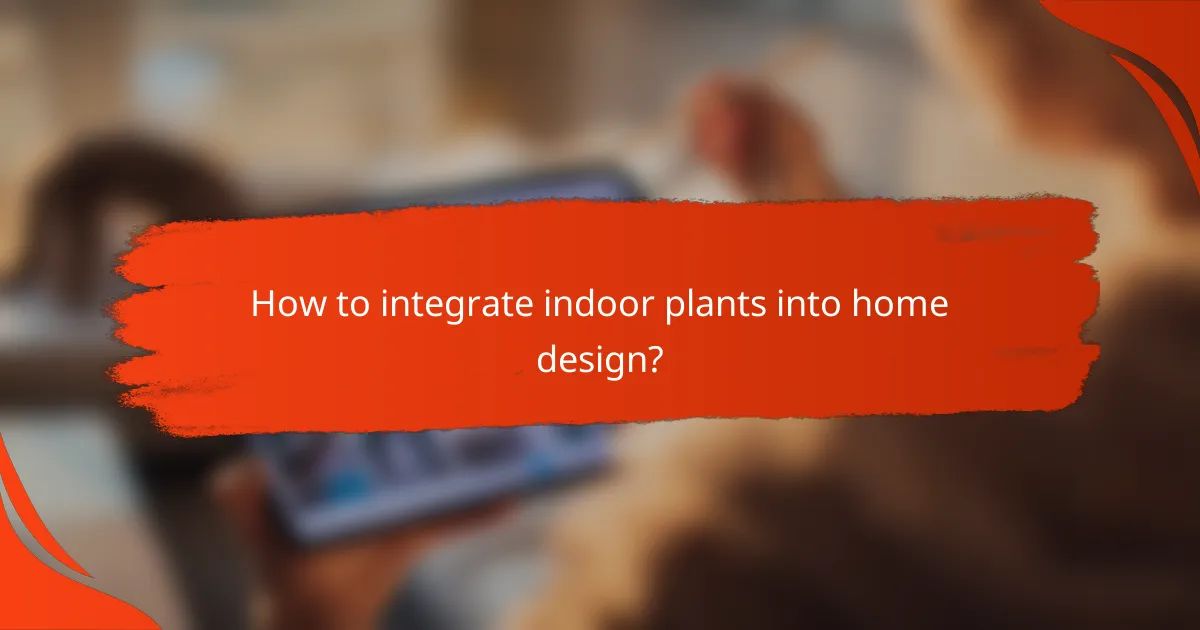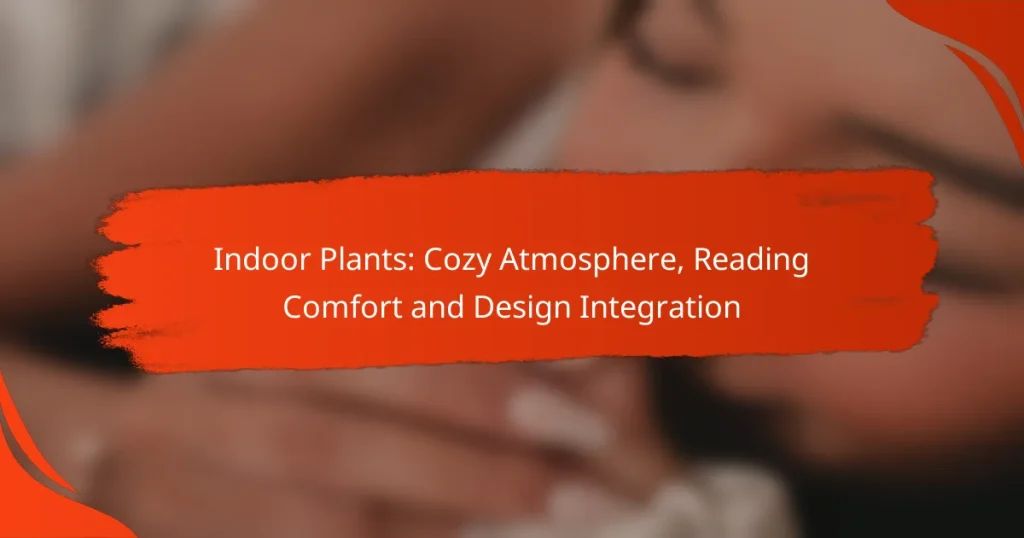Indoor plants not only enhance the aesthetic appeal of a space but also contribute to a cozy atmosphere that promotes relaxation and reading. By improving air quality and providing a calming presence, these plants can transform any room into a comfortable sanctuary. Thoughtful integration of greenery into your home design, considering factors like pot selection and lighting, can further elevate the overall ambiance.

How do indoor plants create a cozy atmosphere?
Indoor plants create a cozy atmosphere by enhancing the overall environment through improved air quality, aesthetic appeal, and psychological benefits. Their presence can transform a space into a more inviting and comfortable area, ideal for relaxation and reading.
Improved air quality
Indoor plants can significantly enhance air quality by absorbing carbon dioxide and releasing oxygen. Many common houseplants, such as spider plants and peace lilies, are known for their air-purifying abilities, helping to reduce indoor pollutants.
To maximize air quality benefits, consider placing multiple plants in a room, as this can increase their overall effectiveness. Aim for a variety of species to target different toxins, as some plants are better at filtering specific chemicals.
Enhanced aesthetics
Plants add visual interest and warmth to any space, contributing to a more inviting atmosphere. Incorporating greenery can soften hard lines and create a sense of balance in interior design.
Choose plants that complement your existing decor. For example, tall plants like fiddle leaf figs can serve as statement pieces, while smaller succulents can be used as accents on shelves or tables.
Increased humidity
Indoor plants naturally release moisture into the air through a process called transpiration. This increase in humidity can help create a more comfortable environment, particularly in dry climates or during winter months when heating systems can lower indoor humidity levels.
To achieve optimal humidity levels, consider grouping plants together. This not only enhances humidity but also creates a lush, green focal point in your space.
Psychological benefits
Having indoor plants can positively impact mental health by reducing stress and promoting feelings of well-being. Studies suggest that interacting with plants can lower anxiety levels and improve mood.
To leverage these psychological benefits, incorporate plants into your daily routine. Spend time caring for them or simply enjoy their presence while reading or relaxing, as this can enhance your overall comfort and satisfaction in your living space.

Which indoor plants are best for reading comfort?
Indoor plants that enhance reading comfort typically offer a calming presence and improve air quality. Consider plants that thrive in low light and require minimal maintenance, as they can create a cozy atmosphere conducive to reading.
Snake Plant
The Snake Plant is an excellent choice for reading comfort due to its low light tolerance and air-purifying qualities. Its tall, upright leaves add a modern touch to any space while filtering out toxins, making the environment healthier.
Place it in a corner or on a shelf where it can receive indirect sunlight. Water it sparingly, allowing the soil to dry out between waterings to prevent overwatering, which can lead to root rot.
Pothos
Pothos is a versatile indoor plant known for its trailing vines and heart-shaped leaves, which can create a relaxing atmosphere. It thrives in various lighting conditions, from low light to bright indirect light, making it easy to integrate into your reading nook.
To care for Pothos, keep the soil slightly moist but not soggy. Prune the vines regularly to encourage bushier growth and maintain its aesthetic appeal. Consider hanging it in a macramé holder for a stylish touch.
Peace Lily
The Peace Lily is favored for its elegant white blooms and ability to thrive in low light, making it perfect for reading areas. It not only enhances the decor but also helps improve indoor air quality by removing harmful pollutants.
Ensure the soil remains consistently moist but not waterlogged. Peace Lilies can droop when thirsty, providing a clear signal for watering. They prefer humidity, so misting the leaves occasionally can enhance their health.
Spider Plant
Spider Plants are known for their arching leaves and small “pups,” which can be propagated easily. They adapt well to various light conditions and are particularly resilient, making them suitable for beginners.
Water the Spider Plant when the top inch of soil feels dry. They thrive in well-drained soil and benefit from occasional fertilization during the growing season. Their air-purifying properties contribute to a fresh reading environment.

How to integrate indoor plants into home design?
Integrating indoor plants into home design enhances aesthetics and creates a cozy atmosphere. To achieve this, consider factors such as pot selection, placement, color coordination, and lighting to ensure your plants thrive and complement your interior decor.
Choosing the right pots
Selecting the right pots is crucial for both plant health and design appeal. Choose pots that have drainage holes to prevent overwatering, and consider materials like ceramic, terracotta, or plastic based on your style preference and budget.
For a cohesive look, match the pot style with your home’s decor. For example, sleek modern pots work well in contemporary spaces, while rustic pots can enhance a farmhouse aesthetic.
Placement strategies
Placement of indoor plants should enhance both their growth and your living space. Position plants near windows for natural light, but avoid direct sunlight for sensitive species. Grouping plants together can create a lush, inviting focal point.
Consider vertical space by using shelves or hanging planters to maximize floor area. This strategy not only saves space but also adds visual interest at different heights.
Color coordination
Color coordination between plants and their pots can significantly impact your home’s design. Choose pot colors that complement your walls and furniture; neutral pots can blend seamlessly, while bold colors can serve as statement pieces.
Incorporating plants with varied foliage colors, such as deep greens, variegated leaves, or colorful blooms, can enhance the overall aesthetic. Aim for a balanced palette that ties together the room’s elements.
Lighting considerations
Lighting is a critical factor in plant health and should align with your home design. Assess the natural light available in each room and select plants that thrive in those conditions, whether low-light or bright, indirect light.
For areas with insufficient natural light, consider using grow lights to support plant growth. These can be integrated into your decor, providing both functionality and style.

What are the benefits of indoor plants in urban environments?
Indoor plants offer numerous benefits in urban settings, including improved air quality, enhanced aesthetics, and increased comfort. They can transform small spaces into inviting areas, making them essential for city dwellers seeking a cozy atmosphere.
Space optimization
Indoor plants can effectively optimize limited urban spaces by adding vertical greenery or utilizing small corners. Choosing compact varieties, such as succulents or pothos, allows for creative arrangements that maximize visual appeal without overwhelming the area.
Consider using wall-mounted planters or hanging pots to free up floor space while still enjoying the benefits of greenery. This approach not only enhances the design but also contributes to a more spacious feel in smaller apartments.
Noise reduction
Plants can help reduce noise levels in urban environments by acting as natural sound barriers. Foliage absorbs, deflects, or refracts sound, which can be particularly beneficial in bustling city areas where noise pollution is common.
Incorporating larger plants, such as rubber trees or fiddle leaf figs, can enhance this effect. Placing them strategically near windows or walls that face busy streets can create a quieter, more peaceful indoor atmosphere.
Stress relief
Having indoor plants can significantly alleviate stress and improve overall well-being. Studies suggest that interacting with plants can lower blood pressure and reduce feelings of anxiety, making them a valuable addition to any urban home.
To maximize stress-relief benefits, consider incorporating a variety of plants that require different care levels. This diversity allows for a rewarding hobby while providing a calming environment, ideal for unwinding after a hectic day in the city.

How to care for indoor plants in different climates?
Caring for indoor plants varies significantly depending on the climate. Factors such as temperature, humidity, and light availability influence watering, fertilization, and placement of plants.
Watering frequency
Watering frequency is crucial for maintaining healthy indoor plants, and it can differ based on climate conditions. In warmer, drier climates, plants may require more frequent watering, while in cooler, more humid environments, less frequent watering is often sufficient.
A general rule is to check the top inch of soil; if it feels dry, it’s time to water. Most indoor plants thrive with watering every 1-2 weeks, but this can vary. For instance, succulents and cacti need less frequent watering compared to tropical plants.
To avoid overwatering, ensure pots have drainage holes and consider using moisture meters for more precise care. Remember that factors like plant type and pot size also affect how often you should water.


